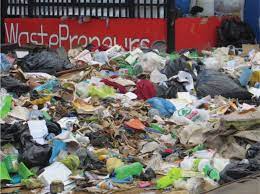From an Article by James Bruggers, Inside Climate News, 9/11/22
After two years, Brightmark Energy has yet to get the factory up and running. Environmentalists say pyrolysis requires too much energy, emits greenhouse gases and pollutants, and turns plastic waste into new, dirty fossil fuels.
‘Greenwashing Up the Wazoo’
The company, which is also developing manure-to-gas projects across the United States, markets its Ashley plant as a “plastics renewable facility” in an effort to try to position itself as a green solution to global plastics and climate crises. For the Ashley plant, it commissioned a study known in the industry as an “environmental lifecycle analysis” from consultants at Environmental Clarity, Inc.
The report found that, when compared to a typical waste stream in the United States where 17 percent of plastic waste is incinerated, the Brightmark pyrolysis plant produces 39 percent fewer greenhouse gas emissions than equivalent products made from virgin materials.
The study’s carbon footprint analysis may be true, said Terrence Collins, a professor of green chemistry at Carnegie Mellon University and director of the CMU Institute for Green Science. But he said there are too many assumptions built into the study for him to know for sure. The study was also silent on many other potential environmental impacts that are often included or should be, in any lifecycle analyses of an industrial process, Collins said.
Its biggest flaw, Collins said, was to give short shrift to the plant’s potential environmental impacts from toxic chemical emissions, including dioxins and common additives to plastics that are known to be endocrine disruptors. Those are hormone-mimicking chemicals that, once inhaled or consumed, can cause reproductive and developmental problems in fetuses. “I did not see a single measurement for dioxin, or even talking about it,” in the report, he said. “You don’t find endocrine disruption as a term. You don’t find health” mentioned, he added.
“It’s greenwashing up the wazoo,” Collins said of the incomplete lifecycle analysis, combined with how Brightmark markets itself on its website using the children of one of its engineers using plastic toys and talking about the need to stop ocean-dumping of plastics.
“They are proposing to go into a regime of more sustainability technology, and they should be held to task,” Collins said. They are “creating a case for no toxics without the science,” and “having it done by a little kid whose generation will be impacted. If you market through children, you raise the stakes; you really need to prove it,” Collins said.
In an email, Environmental Clarity’s Evan Griffing, co-author of the lifecycle analysis, said the study’s scope was established by Brightmark. “Dioxin production in incineration and pyrolysis is certainly a well-known danger,” he said. Dioxin production can be reduced by controlling the temperature of pyrolysis and removing chlorine. The lifecycle analysis mentioned that Brightmark used scanning technology to minimize PVC getting into its pyrolysis system, he said.
Griffing and the study’s other co-author, Michael Overcash, defended their work and the company’s plans in a joint statement in a press release in November. “Brightmark’s plastic renewal technology reduces fossil fuel extraction, reduces landfill and incineration of waste, and cuts down carbon emissions relative to current practice,” said Griffing and Overcash. “We believe efforts to scale advanced plastic recycling technologies like Brightmark’s solution will provide substantial environmental and sustainability benefits to society.”
But numbers contained in the lifecycle analysis further strengthened the criticism that the company isn’t really recycling plastic. In its analysis, the study shows that just 16 percent of the plastic waste entering the plant and just 20 percent of what enters the pyrolysis process after sorting, would actually be converted to naphtha, the plastics feedstock.
Regardless, “the benefit of this technology is substantial compared to the current fate of the majority of post-use plastics,” said Chrystal Boone, a Brightmark vice president.
Is Chemical Recycling Possible?
From questions about what should be considered recycling to environmental and health concerns, the Brightmark plant showcases how the nation is at a potential point of inflection when it comes to what it will do about the crisis of plastic waste. A big part of that discussion is the role of chemical recycling and pyrolysis.
Brightmark’s optimistic outlook in Ashley took a hit earlier this year, after delays at its Ashley plant caused the company pain in Georgia. During the last year, Brightmark made a play to develop a second, even larger pyrolysis plant for plastic waste in Macon, Georgia. But an agreement with a local development authority that had included issuing $500 million in bonds to help pay for the project was terminated in April after Brightmark was unable to show how it could “deliver end-product to one or more off-takers” at its plant in Ashley, according to local news accounts and national trade press.
Local and national environmental advocates who saw the Macon deal as a potential launching pad for Brightmark’s global aspirations are still celebrating what they see as a victory. Brightmark is recalibrating while making a case for its role in what it sees as an emerging industry.
Powell, the company’s CEO, described the Macon situation as “unfortunate” and said the company is looking for other potential locations in the Southeast while focusing on launching the Ashley plant. As for Schabel, he said he’s looking forward to getting the Ashley plant running. “I want to bring the critics in and show them,” he said.
>>> James Bruggers, Reporter, Southeast, National Environment Reporting Network

